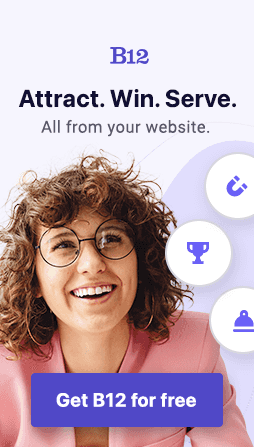Build an AI website in 60 seconds
AI generates your personalized website instantly with built-in scheduling, payments, email marketing, and more.
Start for free
Understanding push vs. pull marketing

Are you struggling to promote your product or service? Do you know the difference between push marketing and pull marketing? Understanding these marketing strategies is crucial to creating an effective promotional campaign that drives results. It also helps you figure out when to use each approach best. For instance, it’s worth noting that 71% of consumers prefer pull marketing.
In this article, we'll explore push and pull marketing. We'll also examine how to choose the right approach and implement the push-pull method to optimize your marketing efforts.
Understanding the differences between push and pull marketing
There are two main marketing approaches that businesses can use to promote their products or services and increase sales. These are push marketing and pull marketing. Understanding the differences between these two strategies lets you develop an effective promotional plan. It helps you ensure that the plan suits your business needs, target audience, and budget.
Push and pull marketing strategy
Push marketing focuses on actively pushing your product or service to potential customers through direct advertising, sales promotions, or personal selling. In this approach, businesses focus on building a strong brand image and creating a wide customer base through various tactics that aim to increase brand awareness.
Pull marketing, on the other hand, attracts customers to your product or service. It does so by creating a desire or demand for it. This approach involves creating valuable and relevant content that appeals to your target audience. It’s about building a strong online presence and offering exceptional customer service. In addition, it involves establishing your business as a thought leader in your industry.
Importance of choosing the right strategy
Choosing the correct marketing strategy is crucial to your business’s overall success. A well-executed marketing campaign can increase brand awareness. It can attract new customers and create a positive reputation for your business.
However, using the wrong approach can lead to wasted resources. It can result in a lack of sales and a negative reputation.
Push marketing
Push marketing is a traditional method of promoting products or services. It's also known as outbound marketing. In this approach, marketers use various marketing techniques to push their products or services toward the targeted customers.
Examples of push marketing approaches
Television commercials, print ads, email marketing, and telemarketing are some examples of push marketing approaches. Marketers use these methods to reach their target audience and compel them to make a purchase.
Advantages and disadvantages of push marketing strategy
Push marketing allows marketers to reach a large number of people in a short period. However, it's more intrusive and disruptive, which can turn off potential customers. It can also come across as aggressive and pushy.
When to use push marketing
Push marketing is suitable for businesses that have a new product in the market. It’s also suitable if you want to target a specific customer group. For example, if a company launches a new shampoo, it can use push marketing to promote its product on television to reach a broader audience.
Pull marketing
Pull marketing is an inbound marketing strategy. It’s all about attracting potential customers to your brand and creating a loyal customer base.
What is pull marketing
Pull marketing aims to engage potential customers by providing them with valuable and informative content. The idea behind a pull strategy is to create content that attracts customers to your brand without explicitly promoting your products or services.
Examples of pull marketing strategies
Examples of pull marketing techniques include search engine optimization (SEO) and content marketing. Other examples include social media marketing, video marketing, and influencer marketing. These techniques provide value and educational content, which helps establish your brand as an authority in the field and pull customers to your business.
Advantages and disadvantages of pull marketing
One of the primary benefits of pull marketing is that it helps create brand loyalty. It creates a positive reputation and establishes trust with potential customers. Pull marketing also has a longer-lasting impact on the audience, unlike push marketing campaigns, which can feel intrusive and less authentic. However, pull marketing campaigns can be more complex and expensive to execute. They require a lot of effort and resources to create engaging content that will pique the interest of potential customers.
When to use pull marketing
Pull marketing is ideal for brands that want to establish a strong online presence and attract more website traffic. If you want to create engagement with your audience and build a positive reputation, pull marketing is worth considering. This approach is also beneficial for B2B companies looking to create long-term relationships with their clients. Since pull marketing focuses on providing value to the audience, it allows your brand to be discovered organically, leading to a higher-quality pool of customers.
Push vs. pull marketing: choosing the right approach
When creating a digital marketing campaign, choosing between push and pull marketing is crucial to achieving the desired outcome. Both approaches have their pros and cons. Ultimately, the choice depends on various factors. These include your target audience, product or service type, and business goals.
Factors to consider when choosing
Several factors should be considered when choosing between push and pull marketing. You need to identify the target audience and understand their decision-making process. For example, push marketing tactics may be more successful for impulse purchases, while pull marketing may work better for products or services that require research and consideration. It is also vital to assess the competition and determine where the brand fits in the market.
Tips for creating a successful campaign
Regardless of the approach used, you need to understand your target audience and their needs to create a successful campaign. It is crucial to craft a consistent message that resonates with the audience. Ensure that it aligns with your brand's values as well. Depending on the approach, marketing channels and tactics should be carefully selected and executed. You should also measure the campaign's success and make adjustments as needed.
Real-life examples of companies that use push and pull marketing
Examples of companies that have successfully utilized both push and pull marketing include PepsiCo and Apple. PepsiCo uses a push marketing approach by investing heavily in advertising and sales promotions to encourage impulse purchases. In contrast, Apple uses a pull marketing approach by focusing on brand experience and value to attract loyal customers. Overall, the approach chosen ultimately depends on the brand's specific needs and should be carefully considered and executed.
Implementing push-pull method
The push-pull method is a combination of both push and pull marketing approaches. Instead of using one strategy exclusively, it involves strategically utilizing both methods to create a more effective promotional campaign.
The push-pull method
The push-pull method combines the use of advertising and promotion to push products toward the customer while also using techniques to pull the customer toward the product. This method aims to provide a more comprehensive marketing approach that considers both the business and customer goals.
Step-by-step guide to implementing push-pull method
To implement the push-pull method, businesses need to take certain steps to ensure success. Firstly, businesses should conduct market research. This helps you understand what appeals to your target audience. You can use that knowledge to create a marketing campaign that addresses specific customer needs. Secondly, businesses should utilize push marketing by creating advertisements that promote and highlight the unique features of their products and services. Thirdly, businesses should use pull marketing by creating educational content and valuable resources that attract customers.
Advantages and disadvantages of the push-pull method
The push-pull method combines the best of both worlds by combining the power of advertising and promotion. Additionally, it creates a more comprehensive marketing strategy that addresses both the business and customer goals. However, some potential disadvantages of this method include difficulty in execution and the possibility of diluting the marketing message.
By employing the push-pull method, businesses can create a marketing campaign that provides a more well-rounded experience for customers. The combination of push and pull marketing allows businesses to reach customers through various channels, increasing the chances of success for their promotional campaigns.
Developing your promotional strategy
After understanding the differences between push and pull marketing, the next step is developing your promotional strategy. Below are some guidelines for creating a successful campaign and measuring its success.
Tips for developing your promotional strategy
Identify your target audience. Who are they? What are their interests, needs, and pain points? This information will help you craft messages that resonate with your audience and lead to engagement.
Next, create a budget allocation for your campaign. Determine which channels you want to use. Identify how much you are willing to spend on each. Consider your company’s size, the nature of your business, and your campaign’s timing.
The importance of measuring success
It is vital to measure the success of your promotional strategy. Use metrics such as the amount of traffic generated on your website. Monitor the number of leads generated and the number of sales made. Additionally, measure engagement on social media and the number of shares of your content.
Boost your growth efforts with B12
Understanding push and pull marketing helps you implement an effective promotional strategy. The right approach helps you develop a campaign that resonates with your target audience and generates results.
To boost your marketing efforts, it’s worth ensuring that your business has a solid online presence, including a website. A quality website can augment your marketing efforts, helping drive traffic to your site and providing your clients with a positive user experience.
B12's website builder is an all-in-one platform for professional services. Attract leads, win business, and serve clients online with a professional site, scheduling, payments, intake, and more. Build your free site today.
Attract, win, and serve more clients
Receive helpful resources directly to your inbox to help you succeed online.
Draft your site in 60 seconds
Get an AI website made specifically for you that's free to launch.
Start for free ✨No credit card required
Spend less time on your website and more time growing your business
Let B12 set up your professional online presence with everything you need to attract, win, and serve clients.





